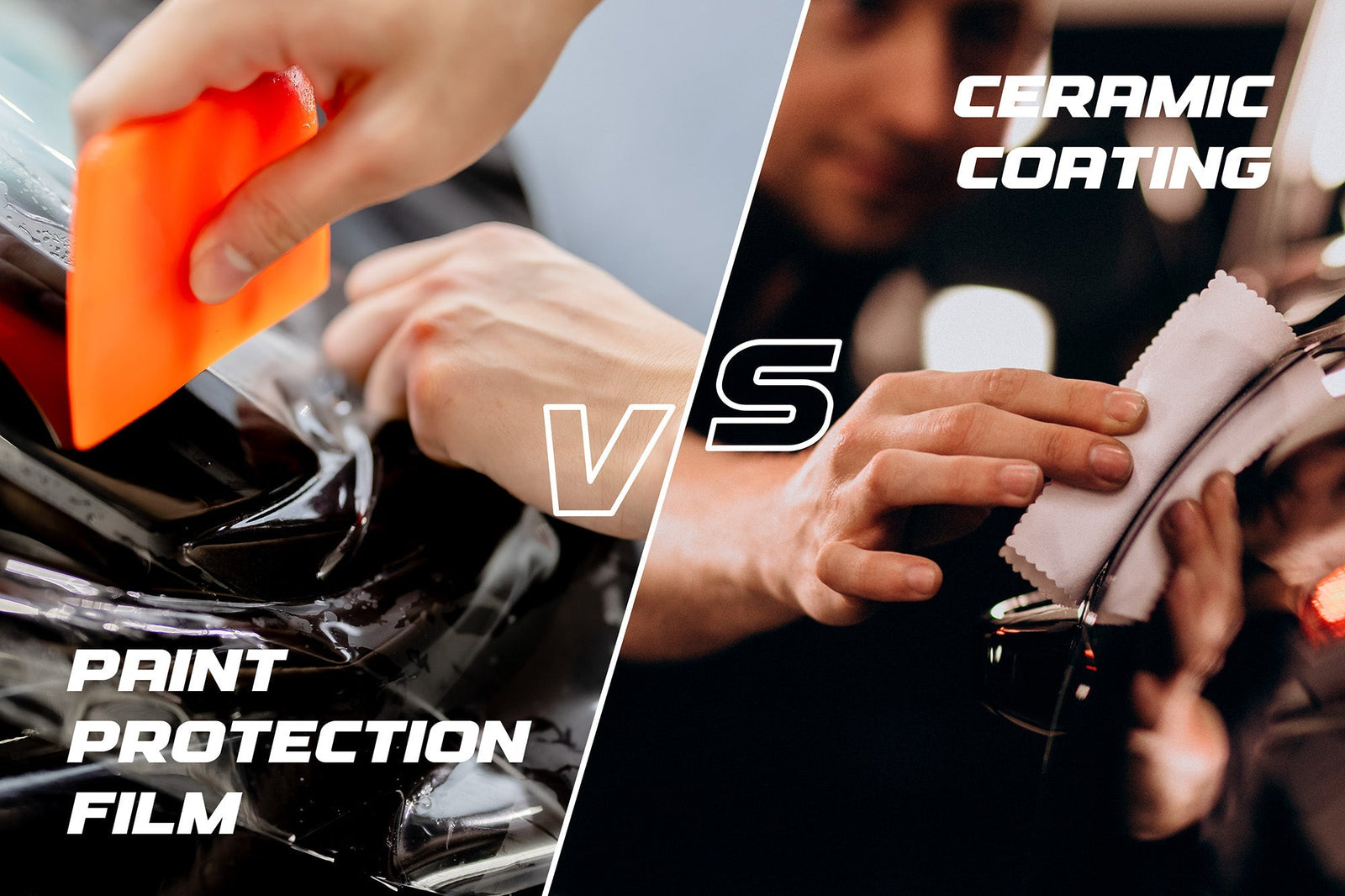Choosing the right form of protection for the original paintwork of your car can be overwhelming, especially for those new to automotive care. Among the most popular options available, paint protection film and ceramic coating both offer high levels of defense, but in different ways. PPF acts as a physical barrier against rock chips and scratches, while ceramic coating improves gloss and makes cleaning easier by repelling water and contaminants. This guide is designed to help customers understand the key differences between the two, so they can decide which option best fits their vehicle's needs and their expectations.
What is a Paint Protection Film?
A Paint Protection Film is a transparent wrap for the exterior of your car made with thermoplastic polyurethane. It acts as a protective barrier against scratches, marks, rock chips, and road debris, and keeps the paint job looking spotless. It is self-healing, as minor marks may disappear from its surface upon exposure to heat. The added advantage of UV protection prevents the paint from fading underneath as well. It is also hydrophobic, allowing water and mud to bead up and slide off the surface, making maintenance and cleaning easier. Moreover, it is thicker than ceramic coating and lasts for 5 to 7 years, making it an incredibly durable option.
Understanding the Ceramic Coating
On the other hand, ceramic coating is a liquid polymer solution that chemically bonds with the car's factory paint, creating a protective layer. It adds a glossy look and is water repellent as well, which contributes to the vehicle’s aesthetic appeal. It also protects against chemical stains and UV damage, which prevents paint fading and oxidation. However, this coating may not be able to shield against road debris and scratches, and has a comparatively shorter lifespan of about 2-5 years.
Differences between PPF and Ceramic Coating
Let’s see the main differences between these two remarkable shields for your vehicle’s exterior:
-
PPF Provides More Extensive Protection Than Ceramic Coating
With a paint protection film, you can safeguard the exterior of your ride from stone chips, scratches, and physical abrasions. It also shields against the harmful UV rays and chemicals from bug splatter, tree sap, acid rain, and bird droppings.
The protection offered by ceramic coating is not as comprehensive. It provides chemical resistance and keeps the detrimental UV protection at bay. Scratches and marks can still affect your paintwork. According to the Carzwerk expert guide, “PPF provides stronger physical protection, while ceramic coating offers long-lasting shine and easier maintenance.”
-
PPF is Hydrophobic with Self-healing Properties
A paint protection film can be either hydrophobic or hydrophilic, making it easy to clean the surface. It also has self-healing properties. If it gets minor scratches, you just have to expose it to heat, and they will heal themselves. This means it retains its smooth and perfect look for a longer time.
Ceramic coating is hydrophobic. While it helps repel water, dirt, and some chemicals, it offers no protection against rock chips or swirl marks and cannot recover from physical damage like a self-healing film can. This affects its durability, too.
-
PPF has a Different Physical Composition than Ceramic Coating
PPF and ceramic coating differ significantly in their material composition. PPF is made from a multi-layered thermoplastic polyurethane, a flexible and durable film designed to conform to the contours of a vehicle's surface. It typically includes a clear coat layer, a polyurethane base, and an adhesive backing. It is generally applied wet, but air channels can also be integrated into it to facilitate dry application.
In contrast, ceramic coating is a liquid polymer that chemically bonds with the paint to form a thin, hard layer once cured. While PPF is a solid, stretchable film applied over the surface, ceramic coating bonds with the paint of your car and becomes a hardened shield.
-
Paint Protection Film is More Durable than Ceramic Coating
Paint Protection Film generally has a longer lifespan than ceramic coating due to its thicker composition and resistance to environmental wear. High-quality PPF can last anywhere from 5 to 7 years with proper care, maintaining its clarity and adhesion over time.
Ceramic coating, on the other hand, lasts for 2 to 5 years, depending on the product and maintenance routine. It may gradually lose its hydrophobic effect and gloss as well. PPF tends to retain its structural integrity and protective qualities for a significantly longer period, making it the more durable option.
-
Ceramic Coating vs PPF Cost
Paint protection film is more expensive than ceramic coating. For ceramic coating, expect to pay anywhere between $1,000 and $3,000. If you want to wrap your car in PPF, the cost can be anywhere between $1500 and $9000. The price depends on the quality of the product and the extent of the application. Full vehicle coverage is more expensive than wrapping just the high-impact areas.
PPF involves higher material and labor costs due to its thicker film and complex installation process. While ceramic coating provides good value for enhancing appearance and basic protection, PPF represents a more significant investment aimed at long-term, physical paint preservation.
|
Features |
PPF |
Ceramic Coating |
|
Physical composition |
Made with thermoplastic polyurethane |
Liquid polymer that bonds with your car’s paint |
|
Protection |
Protects against UV rays, minor scratches, and harsh chemicals |
Ensures chemical resistance and safeguards against UV rays |
|
Surface maintenance |
Easy to clean and has hydrophobic and self-healing properties |
Easy to maintain with only hydrophobic features |
|
Lifespan |
Lasts for 5 to 7 years |
Has a shorter lifespan of 2 to 5 years |
|
Thickness |
Ranges from 6 mils to 10 mils |
Ranges from 0.5 to 2 microns |
|
Finish |
Available in satin, matte, and glossy finishes |
Available in a high gloss finish |
|
Cost |
More expensive, with its price ranging between $1500 and $8000 |
Less expensive, with its price ranging between $1000 and $3000 |
PPF or Ceramic Coating: Which is Better?
In terms of durability and longevity, PPF stands as the clear winner. It focuses more on impact protection from daily wear and tear, while ceramic coating mostly resists chemical stains. It is the clear choice of car owners and enthusiasts, as evident from comments on automotive forums. The installation complexity and time range of the two products also differ. The exterior of your car should be completely clean and blemish-free for both the ceramic coating and PPF to adhere properly and give long-lasting performance. Any damage to the paint or the body of the vehicle has to be repaired properly before installation.
Lastly, vehicles with PPF tend to have a higher resale value compared to those with ceramic coating. Both products are excellent choices for your protective needs; however, if you are willing to invest a bit more money, we recommend installing a paint protection film.
When to Use PPF or Ceramic Coating?
Choosing between PPF and ceramic coating depends on the type of protection and appearance you're aiming for. Each offers unique benefits suited to different driving habits, environments, and vehicle care goals. Understanding when to use one over the other or when to combine both can help maximize the longevity and appearance of your vehicle’s finish.
- New or Luxury Vehicle: If you have recently purchased an expensive car you wish to preserve, PPF will keep it in pristine condition.
- Driving in Harsh Conditions: For those who frequently drive in construction zones or highways, basically anywhere that makes your vehicle prone to scratches, PPF is great for protecting against them.
- For Long-Term Protection: With its longer lifespan and self-healing properties, PPF offers durable physical protection.
- Aesthetic Appeal: If you want a glossy shine and ease of maintenance, ceramic coating excels when it comes to swift washing and cleaning.
-
On a Budget: Ceramic coatings offer a great balance of protection and aesthetics at a lower initial cost than full PPF.
What about a combination of both? If you want to get the best of both worlds, get a combo of PPF and ceramic coating. First, install the paint protection film on your ride, then apply ceramic coating on top of it. This offers the most comprehensive protection for a vehicle’s exterior. This layered approach not only improves the gloss and depth of the paint but also extends the life of both the film and the underlying paintwork. Together, they deliver both long-term durability and a consistently polished appearance. Various auto detailing companies vouch for their highest grade protection.
Wrapping It Up
Selecting between PPF, ceramic coating, or a combination of both ultimately comes down to your priorities for vehicle care. Each option serves a distinct role in preserving your car’s appearance and value over time. Understanding their differences allows for a more informed choice tailored to your driving habits, environment, and long-term maintenance goals.
Our recommendation: Browse through the PPF range at Teckwrap and select one that best suits your needs. With different finishes and high performance, your vehicle is sure to remain in brand-new condition. Though it is enough on its own, if you want to reinforce the protection and have the budget for it, get it ceramic coated and enjoy a carefree drive around town, knowing your car stays cleaner, shinier, and better protected with every mile.

